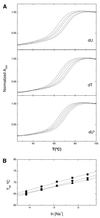Incorporation of a cationic aminopropyl chain in DNA hairpins: thermodynamics and hydration
- PMID: 11522834
- PMCID: PMC55897
- DOI: 10.1093/nar/29.17.3638
Incorporation of a cationic aminopropyl chain in DNA hairpins: thermodynamics and hydration
Abstract
We report on the physicochemical effects resulting from incorporating a 5-(3-aminopropyl) side chain onto a 2'-deoxyuridine (dU) residue in a short DNA hairpin. A combination of spectroscopy, calorimetry, density and ultrasound techniques were used to investigate both the helix-coil transition of a set of hairpins with the following sequence: d(GCGACTTTTTGNCGC) [N = dU, deoxythymidine (dT) or 5-(3-aminopropyl)-2'-deoxyuridine (dU*)], and the interaction of each hairpin with Mg(2+). All three molecules undergo two-state transitions with melting temperatures (T(M)) independent of strand concentration that indicates their intramolecular hairpin formation. The unfolding of each hairpin takes place with similar T(M) values of 64-66 degrees C and similar thermodynamic profiles. The unfavorable unfolding free energies of 6.4-6.9 kcal/mol result from the typical compensation of unfavorable enthalpies, 36-39 kcal/mol, and favorable entropies of approximately 110 cal/mol. Furthermore, the stability of each hairpin increases as the salt concentration increases, the T(M)-dependence on salt yielded slopes of 2.3-2.9 degrees C, which correspond to counterion releases of 0.53 (dU and dT) and 0.44 (dU*) moles of Na(+) per mole of hairpin. Absolute volumetric and compressibility measurements reveal that all three hairpins have similar hydration levels. The electrostatic interaction of Mg(2+) with each hairpin yielded binding affinities in the order: dU > dT > dU*, and a similar release of 2-4 electrostricted water molecules. The main result is that the incorporation of the cationic 3-aminopropyl side chain in the major groove of the hairpin stem neutralizes some local negative charges yielding a hairpin molecule with lower charge density.
Figures




Similar articles
-
Thermodynamic and hydration effects for the incorporation of a cationic 3-aminopropyl chain into DNA.Nucleic Acids Res. 2002 Jul 15;30(14):3171-80. doi: 10.1093/nar/gkf430. Nucleic Acids Res. 2002. PMID: 12136099 Free PMC article.
-
Coupling of sequential transitions in a DNA double hairpin: energetics, ion binding, and hydration.Biochemistry. 1991 Jun 25;30(25):6276-83. doi: 10.1021/bi00239a028. Biochemistry. 1991. PMID: 2059634
-
Melting studies of short DNA hairpins: influence of loop sequence and adjoining base pair identity on hairpin thermodynamic stability.Biopolymers. 1999 Oct 5;50(4):425-42. doi: 10.1002/(SICI)1097-0282(19991005)50:4<425::AID-BIP8>3.0.CO;2-B. Biopolymers. 1999. PMID: 10423551
-
Melting behavior and ligand binding of DNA intramolecular secondary structures.Biophys Chem. 2011 Nov;159(1):162-71. doi: 10.1016/j.bpc.2011.06.006. Epub 2011 Jun 21. Biophys Chem. 2011. PMID: 21752531
-
Aggregated DNA in ethanol solution.FEBS Lett. 1995 Nov 20;375(3):174-8. doi: 10.1016/0014-5793(95)01206-t. FEBS Lett. 1995. PMID: 7498493 Review.
Cited by
-
Cationic phosphoramidate alpha-oligonucleotides efficiently target single-stranded DNA and RNA and inhibit hepatitis C virus IRES-mediated translation.Nucleic Acids Res. 2003 Sep 15;31(18):5282-90. doi: 10.1093/nar/gkg733. Nucleic Acids Res. 2003. PMID: 12954764 Free PMC article.
-
Cationic oligonucleotide derivatives and conjugates: A favorable approach for enhanced DNA and RNA targeting oligonucleotides.Beilstein J Org Chem. 2021 Jul 29;17:1828-1848. doi: 10.3762/bjoc.17.125. eCollection 2021. Beilstein J Org Chem. 2021. PMID: 34386102 Free PMC article. Review.
-
Thermodynamic and hydration effects for the incorporation of a cationic 3-aminopropyl chain into DNA.Nucleic Acids Res. 2002 Jul 15;30(14):3171-80. doi: 10.1093/nar/gkf430. Nucleic Acids Res. 2002. PMID: 12136099 Free PMC article.
-
Changes in DNA bending and flexing due to tethered cations detected by fluorescence resonance energy transfer.Nucleic Acids Res. 2006 Feb 14;34(3):1028-35. doi: 10.1093/nar/gkj498. Print 2006. Nucleic Acids Res. 2006. PMID: 16481311 Free PMC article.
-
DNA bending by bHLH charge variants.Nucleic Acids Res. 2006;34(17):4846-56. doi: 10.1093/nar/gkl552. Epub 2006 Sep 14. Nucleic Acids Res. 2006. PMID: 16973898 Free PMC article.
References
-
- Hagerman P.J. (1988) Flexibility of DNA. Annu. Rev. Biophys. Biophys. Chem., 17, 265–286. - PubMed
-
- Luger K., Mader,A.W., Richmond,R.K., Sargent,D.F. and Richmond,T.J (1997) Crystal structure of the nucleosome core particle at 2.8 Å resolution. Nature, 389, 251–260. - PubMed
-
- Schultz S.C., Shields,G.C. and Steitz,T.A. (1991) Crystal structure of a CAP–DNA complex: the DNA is bent by 90 degrees. Science, 253, 1001–1007. - PubMed
Publication types
MeSH terms
Substances
Grants and funding
LinkOut - more resources
Full Text Sources
Other Literature Sources

